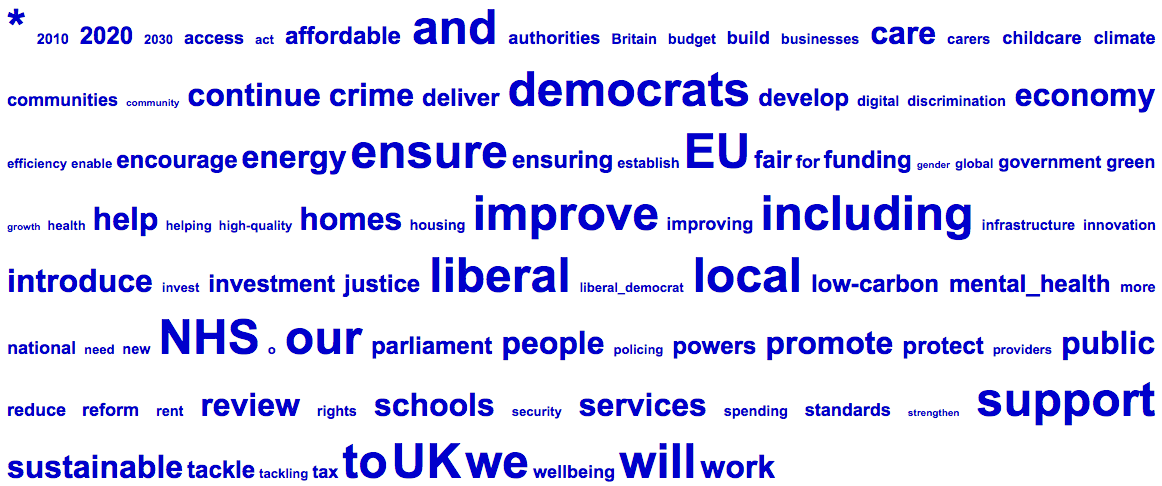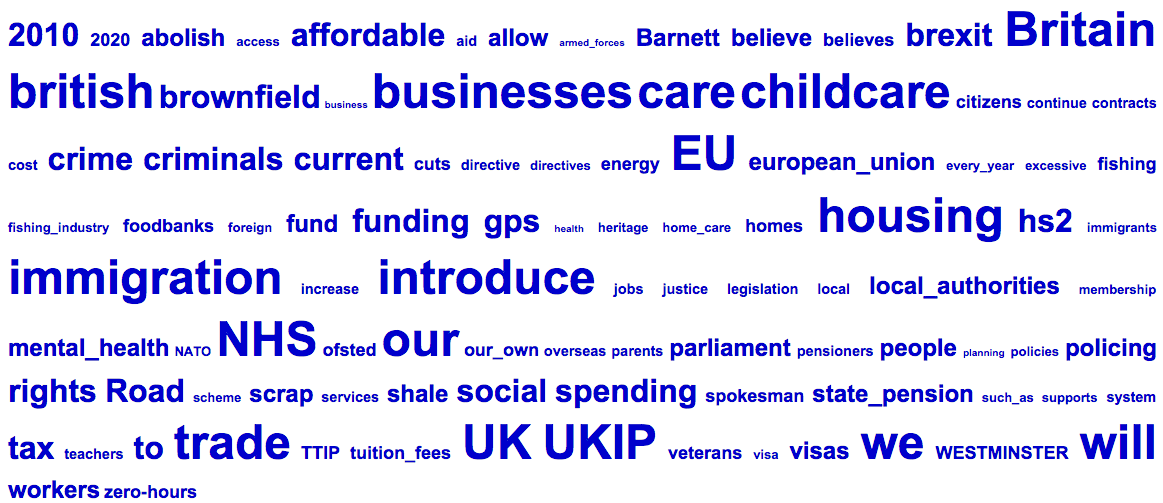 Figure 1: Conservatives Key Word Cloud
Figure 1: Conservatives Key Word Cloud

In addition, you can download crosstabs of word, POS and semantic tag frequencies with log-likelihood and dispersion statistics. These are tab delimited so can be opened in your favourite spreadsheet application.
| Conservatives | Labour | Liberal Democrats | Green Party | Plaid Cymru | Scottish National Party | UKIP | |
| Party website | www.conservatives.com | www.labour.org.uk | www.libdems.org.uk | www.greenparty.org.uk | www.plaid.cymru | www.snp.org | www.ukip.org |
| Launch date | 14 April 2015 | 13 April 2015 | 15 April 2015 | 14 April 2015 | 31 March 2015 | 20 April 2015 | 15 April 2015 |
| Direct link | PDF | TXT | ||||||
| Local copy | |||||||
| Edited text version | TXT | TXT | TXT | TXT | TXT | TXT | TXT |
| Number of words (tokens) | 29,371 | 17,662 | 32,269 | 39,433 | 17,616 | 17,826 | 26,179 |
| Number of unique words (types) | 4,366 | 3,138 | 4,783 | 6,221 | 3,124 | 2,786 | 5,182 |
| Word frequency list | TXT | TXT | TXT | TXT | TXT | TXT | TXT |
| Key word cloud | Figure 1 | Figure 3 | Figure 5 | Figure 7 | Figure 9 | Figure 11 | Figure 13 |
| Key semantic tag cloud | Figure 2 | Figure 4 | Figure 6 | Figure 8 | Figure 10 | Figure 12 | Figure 14 |
As in previous elections, I have made local copies of manifestos available since they often disappear offline after the election. To prepare the text versions, I used Adobe Reader to save as text and then manually edited (using TextWrangler) a small number of items such as headers, footers and page numbers to store them in pseudo-XML-style tags. In addition, I have followed the input format guidelines for CLAWS and converted n-dashes, pound signs, begin and end quotes to XML entities. The Liberal Democrats manifesto is downloadable in text form directly from their website, but I still needed to carry out the character edits on their file. Note that this text version does not contain the index from the end of the PDF version.
A note on word counts: Wmatrix counts semantically meaningful multiword expressions (MWEs) as one item, so other corpus software may well provide different counts here. These figures also depend on tokenisation in our NLP pipeline (by CLAWS).
Word frequency lists are tab delimited so you can load them in to your favourite spreadsheet program. MWEs are shown in the word frequency lists as words connected by underscore characters.
Key word and semantic tag clouds are produced by comparing the data with the BNC Written Sampler corpus. The larger the font, the higher the log-likelihood score, so larger items are more significantly overused compared to the reference corpus. See the Wmatrix main page and online tutorials if you want more details about how this works.
 Figure 1: Conservatives Key Word Cloud
Figure 1: Conservatives Key Word Cloud
 Figure 2: Conservatives Key Semantic Tag Cloud
Figure 2: Conservatives Key Semantic Tag Cloud
 Figure 3: Labour Key Word Cloud
Figure 3: Labour Key Word Cloud
 Figure 4: Labour Key Semantic Tag Cloud
Figure 4: Labour Key Semantic Tag Cloud
 Figure 5: Liberal Democrats Key Word Cloud
Figure 5: Liberal Democrats Key Word Cloud
 Figure 6: Liberal Democrats Key Semantic Tag Cloud
Figure 6: Liberal Democrats Key Semantic Tag Cloud
 Figure 7: Green Key Word Cloud
Figure 7: Green Key Word Cloud
 Figure 8: Green Key Semantic Tag Cloud
Figure 8: Green Key Semantic Tag Cloud
 Figure 9: Plaid Cymru Key Word Cloud
Figure 9: Plaid Cymru Key Word Cloud
 Figure 10: Plaid Cymru Key Semantic Tag Cloud
Figure 10: Plaid Cymru Key Semantic Tag Cloud
 Figure 11: SNP Key Word Cloud
Figure 11: SNP Key Word Cloud
 Figure 12: SNP Key Semantic Tag Cloud
Figure 12: SNP Key Semantic Tag Cloud
 Figure 13: UKIP Key Word Cloud
Figure 13: UKIP Key Word Cloud
 Figure 14: UKIP Key Semantic Tag Cloud
Figure 14: UKIP Key Semantic Tag Cloud